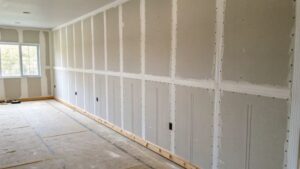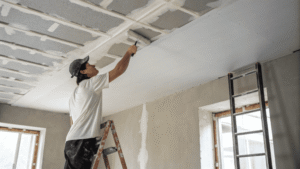Moisture and mold damage can turn any ceiling project into a headache if the wrong material is chosen. PVC laminated ceilings solve these issues with lasting protection.
A PVC laminated ceiling is made from a gypsum board core covered with a PVC film layer, combining gypsum’s structural stability with PVC’s waterproof and easy-clean properties.

Choosing the right ceiling material matters for both durability and maintenance. Many people think PVC laminated ceilings are just plastic or that gypsum boards fit all spaces. In my years of manufacturing, I’ve seen too many costly mistakes from these misunderstandings. That’s why learning the differences is key before deciding.
What is the difference between gypsum board and PVC ceiling?
Moisture is the biggest enemy of any gypsum board in bathrooms or kitchens. Even with a water-resistant coating, high humidity takes its toll.
The main difference is that gypsum boards absorb moisture over time, while PVC laminated ceilings block it, staying mold-free and stable in damp environments.

The structure makes the difference. A PVC laminated ceiling has a gypsum core for stability and fire resistance. Over it is a PVC layer that seals against water vapor. This outer layer keeps the board from swelling, softening, or forming mold spots. I saw this first-hand in a public bathroom renovation we did two years ago. Our PVC laminated panels stayed spotless while the neighboring area with water-resistant gypsum boards showed yellow stains and beginning mold spots after the same period.
Below is a simple comparison to show the difference clearly:
| Feature | Gypsum Board | PVC Laminated Gypsum Board |
|---|---|---|
| Moisture Resistance | Low to medium | High |
| Fire Resistance | High | High |
| Maintenance | Needs repainting | Easy to clean, no repainting |
| Best Application | Dry areas | Wet or humid areas |
What is PVC laminate vs laminate?
Many people ask if PVC laminate is the same as furniture laminate. They are not.
PVC laminate uses PVC film over a gypsum or other core for walls and ceilings, while furniture laminate uses resin-coated paper over engineered wood.

Furniture laminate is made from paper layers soaked with melamine resin, pressed together for a hard decorative surface. It’s great for cabinets, countertops, or flooring, but not designed for wet ceilings and walls. PVC laminate, on the other hand, is moisture-proof by nature. It bonds PVC film directly to the surface of a gypsum ceiling board, making it resistant to steam, stains, and deformation. I have met clients who tried using furniture laminate panels on ceilings in kitchens. Within months, edges started to peel, and boards warped because resin paper can’t handle constant humidity. After switching to PVC laminated ceiling panels, the problems stopped, even with daily cooking steam.
| Feature | PVC Laminated Gypsum Board | Furniture Laminate Panel |
|---|---|---|
| Core Material | Gypsum | MDF/HDF or particle board |
| Surface Layer | PVC film | Melamine resin-coated paper |
| Moisture Resistance | High | Low to medium |
| Typical Use | Ceilings, walls | Furniture, flooring |
What is the difference between Isoboard and PVC ceilings?
Some customers confuse Isoboard with PVC ceilings because both are used in building interiors, but they serve completely different purposes.
Isoboard is made from extruded polystyrene for insulation, while PVC laminated ceilings are for decoration and moisture protection.

Isoboard focuses on thermal insulation. It keeps rooms warmer in winter and cooler in summer but is not designed as a finished ceiling surface. It usually needs to be covered by another material for appearance. PVC laminated ceilings focus on visual appeal and resistance to water, steam, and stains. On some projects, I recommend using both together. In a seaside resort we worked on, we installed Isoboard above for insulation, then PVC laminated gypsum boards as the final ceiling finish. This combination gave both comfort and easy cleaning for humid coastal air. Without PVC laminated ceilings, the moist sea breeze would have ruined the interior finish quickly.
| Feature | Isoboard | PVC Laminated Gypsum Board |
|---|---|---|
| Material | Extruded polystyrene | Gypsum core + PVC film |
| Purpose | Thermal insulation | Decoration + moisture proof |
| Moisture Resistance | Medium | High |
| Installation | Covered by finishing material | Direct as finish surface |
Conclusion
PVC laminated ceilings combine the strength of gypsum with PVC’s moisture protection, making them the smart choice for wet or humid areas where standard materials fail.
TRUSUS – Bring beauty to every corner of the world



